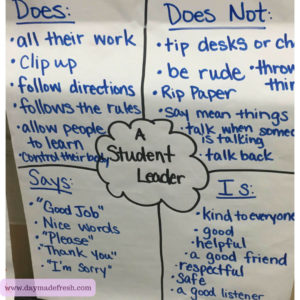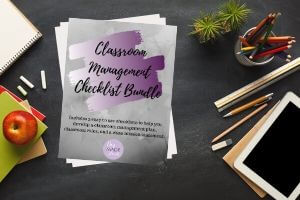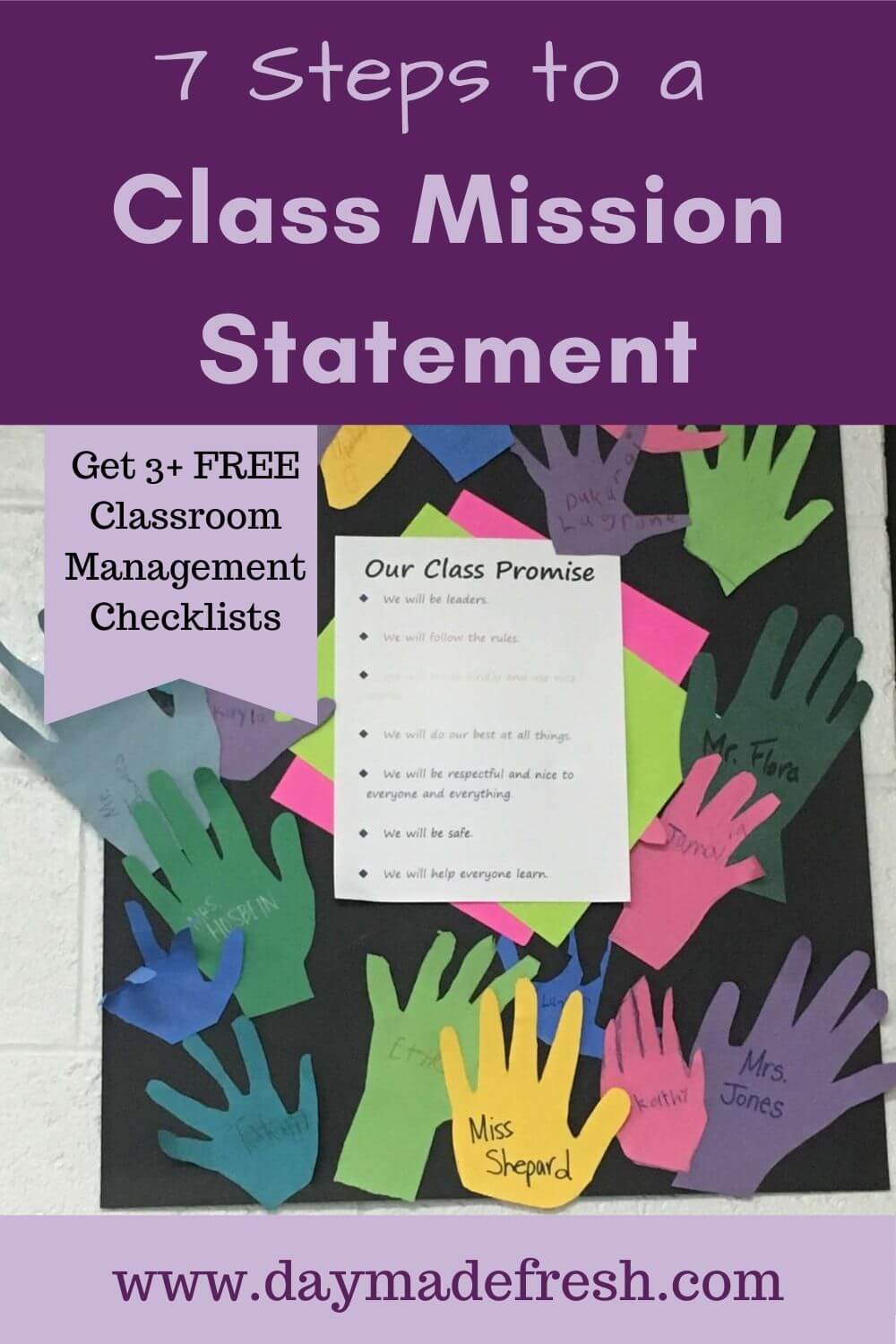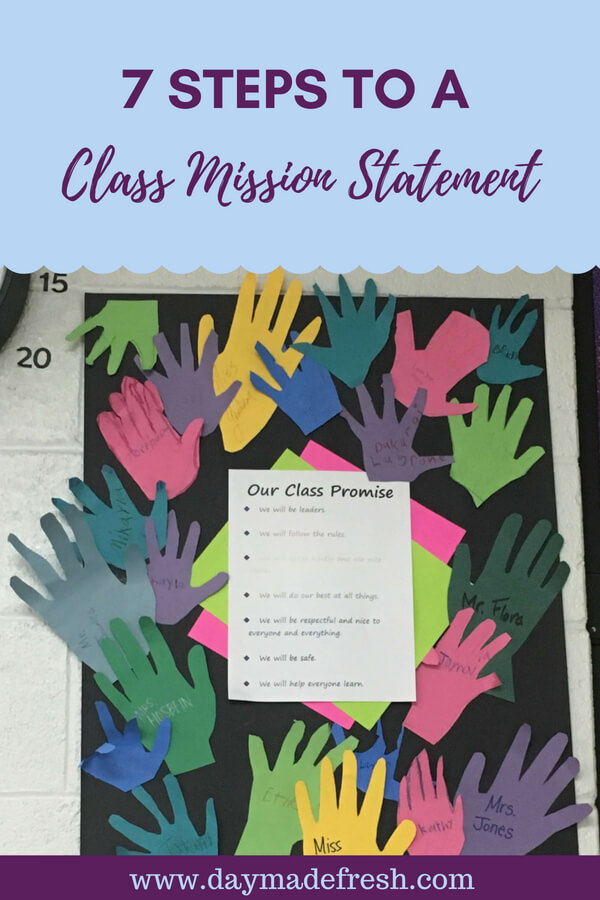Want your students to take more ownership of their choices and behavior, so they begin to self-monitor and manage themselves? Would you like to have a classroom culture that encourages student collaboration and moves the locus of control towards the students? One of the best ways to accomplish these goals and more is by jointly developing a class mission statement with your students.
Having a Class Mission Statement Promotes Student Ownership of the Classroom and their Behavior

I’ve developed a class mission statement with my students for the past few years and have found it extremely beneficial. The first year I tried this process I had my students develop a class mission statement in January. The class was struggling, I could barely teach because I spent the majority of my time dealing with student behaviors and the negative behaviors were spreading instead of improving. As a school, we were starting the process of becoming a Leader in Me school and one component of Leader in Me was developing a class mission statement. (Interested in Leader in Me? Check out The Leader in Me book) I realized I needed to do something to give our class a chance to reset and to set clear expectations together. My hope was that by developing the mission statement together I could get more student by in.
It worked! We spent three to five days discussing, brainstorming, and revising our class mission statement. When we created our poster and posted it in the room I immediately started to hear students start to self-manage themselves and one another. The students that were not causing behavior issues made it clear to the ones that were causing issues that they were not happy with how things were going in the classroom and there were clear guidelines for how they wanted things to be in the classroom. It amazed me to see how this impacted my struggling students. Many of their behaviors started to improve because they didn’t want to disappoint their classmates. I’ve found this to be true every year that I’ve used a class mission statement.
Download a free Classroom Management Checklist Bundle including 7 Steps to a Class Mission Statement.
Over the years, I’ve refined the process of jointly developing a class mission statement. If you use this process with your students and include a class mission statement as part of your classroom management plan, you can create the classroom culture you want.
This post contains some affiliate links for your convenience. Click here to read my full disclosure policy.
Step 1: Student Brainstorms, Discussions, and Anchor Charts
The first step I suggest taking is to have your students envision the classroom and classmates they’d like to have. I start this process during the first two weeks of school after I’ve introduced my classroom rules and most of my expectations and procedures.
Have your students brainstorm their ideal classroom: What does it look like, sound like, feel like, etc.? Depending on the age of your students you can have them draw a picture, write, or visualize in their head. Then come together as a class and lead a discussion covering the same questions. Compile student responses on an anchor chart.
Next, follow the same or a similar process to make another anchor chart that covers what makes a good classmate. I use the sentences stems:
A good classmate is…
A good classmate does…
A good classmate says…
A good classmate does not…
After you’ve had your discussions and created your anchor charts talk as a class about how, as a class, you can ensure that these things happen. Introduce the idea of a class mission statement as a way to accomplish the classes’ goals. (A class mission statement is similar to a class contract if you’ve used or read about those before).
Other anchor chart ideas for this step could be: “A Student Leader…,” “A Bucket Filling Classroom…,” “Respect Looks Like… and Respect Sounds Like…,” “Our Classroom: Things we like & Things we don’t like…,” etc. If you are looking for examples of these anchor charts and more classroom management ideas check out my Pinterest board, here.

Step 2: Preview Class Mission Statement Examples
If students haven’t done this process in the past they often need a stepping off point. (If you feel like your students understand this concept you can skip this step.) I have found it helpful to share examples of other class mission statements. I do a google image search and find around ten examples and make a PowerPoint or Google Slides presentation. This is a great opportunity to gently guide your students in a direction you would like them to go by choosing examples with statements you hope your students will include in their class mission statement.
As you share the examples ask students what they notice and have them point out phrases or statements they like. You can also have students jot down ideas they would like to use later. Remind them that these are just examples and that as a class you will create your own unique class mission statement.
Step 3: Small Group Brainstorm
When the class is ready divide students into small groups (3-4 students) and have them make a list of statements that they would like to include in the class mission statement. If students need more guidance I often tell them to write a list of what students should agree to do at school, so everyone can learn and be successful.
At this time, don’t limit the number of statements students can write. Depending on the age or needs of your class you can also post the class mission statement examples for students to use as they compile their list. I’ve found it beneficial to encourage each student to write at least one statement on their group’s list. This helps to ensure that all students’ voices are heard. I usually give students ten to fifteen minutes for this exercise.
Step 4: Narrow it Down and Create a Draft
Once each group is done come back together and meet as a whole class. Have groups take turns and share out their statements (I encourage them to start with their favorite or most important statement). As you record their statements put a check mark next to any statements that multiple groups have. This helps students begin to see which ideas the majority of students find important.
After everyone has shared, talk about how it would be great to include all of these ideas but to make it easier for everyone to agree to and follow the class mission statement, you need to narrow down the list to 10 or fewer statements. To accomplish this ask students to read through the list and see if any of the statements could be combined and/or revised because they are similar (For younger or less experienced students I usually do one as an example). Then have students read through the list and find any statements that are worded negatively (Don’t say mean things, No Running, etc. ) ask if they can be connected to another statement or reworded in a positive way.
This part of the process can take a while and may need lots of teacher guidance. I would suggest that if students strongly believe that they need a certain statement allow them to keep them in. It will be better to have a longer mission statement than to make students feel that their wants and desires are not respected.
Download a free Classroom Management Checklist Bundle including 7 Steps to a Class Mission Statement.

Step 5: Put it to a Vote
Now that you have a draft of your class mission statement take the class statement by statement and have students vote if they can or cannot agree to follow what is written. I suggest that you wait a day after you’ve completed your draft to do this step. This allows students to see the draft of their mission statement in a fresh light. The process of voting on each statement creates buy-in from students.
Hopefully, as students have been a part of this process from the beginning this should go smoothly. If everyone agrees with the statement check it off as complete. If everyone does not agree with the statement ask students to share why they don’t agree. This often causes students to admit they actually do agree with the statement or gives them a chance to share their feelings.
After students share their thoughts give them an opportunity to suggest revisions. Then have students vote again to see if everyone agrees or if the statement needs to be deleted from the mission statement. This process encourages great discussions among students! If there is a statement that you believe is important, but some students continue to vote against it, I would suggest that you continue to discuss the statement and try to reach an agreement. In the end, this is their class mission statement and they may not think the same as you. It can be hard to give up control, but I find I can balance this out by creating a separate list of class rules that I expect all students to follow (Read more about creating clear, concise class rules: here).
If you have a student that is a challenge behaviorally and he or she is constantly disrupting this part of the process I would suggest possibly removing them from the process. I’d pull them aside and tell them that if they cannot be a positive part of this process they are demonstrating that they do not want a say in how things should be in the class and if they continue with their behavior(s) they will not be able to be a part of this process. I have, unfortunately, had to do this with a few students. I then presented the final class mission statement to the student and said, “This is what your classmates would like the class to be and I hope you can respect their wishes. If you would like to join them, then you are welcome to sign the class mission statement.” In the end, most students chose to join their classmates.
Step 6: Publish and Sign Your Class Mission Statement
Take the final list of statements and create a final copy of the class mission statement. Then have all the students and yourself sign the class mission statement. I would also suggest having any other staff members that work with your class sign your class mission statement. This helps students understand that this mission statement should be respected wherever they are in the school.
To publish the class mission statement, I usually create a poster and post it in a prominent part of the classroom, so that we can refer to it frequently. I have also created copies of the mission statement for each of my students to keep in their binder at their desk. Get creative! You want to make your class mission statement stand out, so it is memorable.
Step 7: Use It!
Creating a class mission statement will mean nothing if you don’t, as a class, use it frequently. This should be a document that you refer to at least once a week; otherwise, there is a good chance your students will forget about it.
Ideas:
- Make it a part of your morning routine by reading it as a class daily.
- Use it to guide class meeting discussions around how to make the class better.
- Include parts of the statements in your behavior tracking system (ie: ClassDojo Points).
- Create positive notes to recognize students that demonstrate following the class mission statement.
- Ask students to reflect on a character or characters in a story and if they are or are not demonstrating behavior that follows the class missions statement.
If you take the time to jointly develop a class mission statement using these 7 steps you will be on the way to creating the classroom culture you want. If your school uses classroom contracts instead of class mission statements you can use the same process. The best way to ensure you have the classroom culture you dream of is to develop a comprehensive, strong classroom management plan. Want help? Check out this post about creating a classroom management plan!
Have questions or want help developing a class mission statement with your class? Please contact me, I’d love to help.
Want ready to print and editable worksheets to help your students through the process? Purchase a bundle from my Teachers Pay Teachers store.


